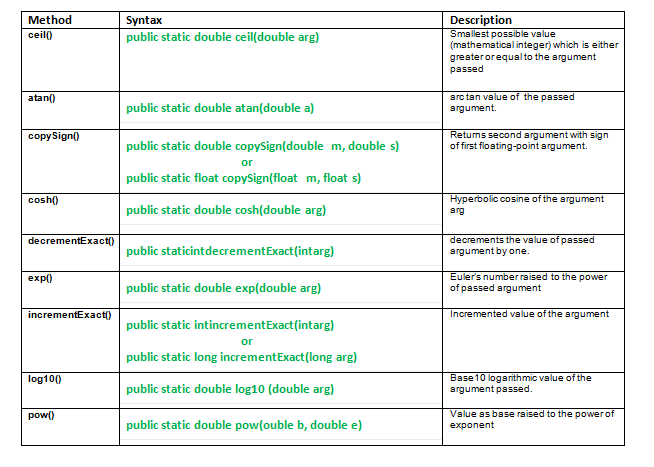java.math class and its methods | Set 3
Last Updated :
19 Aug, 2021
java.math class and its methods | Set 1
java.math class and its methods | Set 2

- ceil() : java.math.ceil(double a) method returns the smallest possible value which is either greater or equal to the argument passed. The returned value is a mathematical integer.Special Case :
- Result is same, if the returned value is already a mathematical integer.
- Result is same, if the passed argument is NaN or infinite or zero.
- Result is negative zero, if the passed argument is less than zero but greater than -1.0
Syntax:
public static double ceil(double arg)
Parameters:
arg - the argument value
Returns:
smallest possible value(mathematical integer)
which is either greater or equal to the argument passed
- atan() : java.math.atan() method returns the arc tangent of the method argument value. The returned angle is in the range -pi/2 through pi/2.
arc tan is inverse tan of the argument passed.
atan(arg) = tan inverse of arg
Special Case :
- Result is NaN, if the passed argument is NaN or its absolute value is > 1.
- Result is zero, if argument is zero.
Syntax:
public static double atan(double a)
Parameters:
a - the argument whose arc tangent value we need.
argument is taken as radian
Returns:
arc tan value of the argument.
- copySign() : java.math.copySign() method returns first floating-point argument but having the sign of second argument.
Syntax:
public static double copySign(double m, double s)
or
public static float copySign(float m, float s)
Parameters:
m - magnitude
s - sign
Returns:
returns second argument with sign of first floating-point argument.
Java code explaining atan(), ceil(), copySign() method in Math class.
Java
import java.math.*;
public class NewClass
{
public static void main(String[] args)
{
double Atani = Math.atan(0);
System.out.println("atan value of Atani : "+Atani);
double x = Math.PI/2;
x = Math.toRadians(x);
double Atanj = Math.atan(x);
System.out.println("atan value of Atanj : "+Atanj);
System.out.println("");
double val = 15.34 ,ceilval;
ceilval = Math.ceil(val);
System.out.println("ceil value of val : "+ceilval);
System.out.println("");
double dblMag = val;
double dblSign1 = 3;
double dblSign2 = -3;
double result1 = Math.copySign(dblMag,dblSign1);
System.out.println("copySign1 : "+result1);
double result2 = Math.copySign(dblMag,dblSign2);
System.out.println("copySign2 : "+result2);
}
}
|
Output:
atan value of Atani : 0.0
atan value of Atanj : 0.0274087022410345
ceil value of val : 16.0
copySign1 : 15.34
copySign2 : -15.34
- cosh() : java.math.cosh() method returns the hyperbolic cosine of the argument passed.
Special cases :
- Result is NaN, if argument is NaN.
- Result is 1.0, if the argument is zero.
- Result is +ve infinity if the argument is infinite.
Syntax:
public static double cosh(double arg)
Parameters:
arg - The number whose hyperbolic cosine is to be returned.
Returns:
the hyperbolic cosine of the argument arg.
- decrementExact() : java.math.decrementExact() method decrements the value of passed argument by one.
Syntax:
public static int decrementExact(int arg)
or
public static long decrementExact(long arg)
Parameters:
arg - argument passed.
Returns:
return argument decremented by one.
Throws:
Exception if the result overflows long or int datatype, according to the
argumented data type.
- exp() : java.math.exp(double arg) method returns the Euler’s number raised to the power of double argument.
Important cases:
- Result is NaN, if argument is NaN.
- Result is +ve infinity, if the argument is +ve infinity.
- Result is +ve zero, if argument is -ve infinity.
Syntax:
public static double exp(double arg)
Parameters:
arg - argument passed.
Returns:
Euler’s number raised to the power of passed argument
Java code explaining exp(), decrementExact(), cosh() method in Math class.
Java
import java.math.*;
public class NewClass
{
public static void main(String[] args)
{
double value = 2;
double coshValue = Math.cosh(value);
System.out.println("Hyperbolic Cosine of " + coshValue);
System.out.println("");
int result = Math.decrementExact(3051);
System.out.println("Use of decrementExact() : " + result);
System.out.println("");
double exponent = 34;
double expVal = Math.exp(exponent);
System.out.println("Value of exp : "+ expVal);
}
}
|
Output:
Using addExact() : 9
acos value of Asini : NaN
acos value of Asinj : 0.054858647341251204
cube root : 6.0
- incrementExact() : java.math.incrementExact() method returns the argument by incrementing it’s value.
Syntax:
public static int incrementExact(int arg)
or
public static long incrementExact(long arg)
Parameters:
arg - the argument
Returns:
incremented value of the argument
- log10() : java.math.log10() method returns the base10 logarithmic value of the passed argument.
Syntax:
public static double log(double arg)
Parameters:
arg - argument passed.
Returns:
base10 logarithmic value of the argument passed.
- pow() : java.math.pow(double b, double e) method returns the value as be
Syntax:
public static double pow(double b,double e)
Parameters:
b : base
e : exponent
Returns:
value as baseexponent
JAVA code explaining incrementExact(), log10(), pow() method in Math class.
Java
import java.lang.*;
public class NewClass
{
public static void main(String[] args)
{
int f1 = 30, f2 = -56;
f1 =Math.incrementExact(f1);
System.out.println("Incremented value of f1 : "+f1);
f2 =Math.incrementExact(f2);
System.out.println("Incremented value of f2 : "+f2);
System.out.println("");
double value = 10;
double logValue = Math.log10(value);
System.out.println("Log10 value of 10 : "+logValue);
System.out.println("");
double b = 10, e = 2;
double power = Math.pow(b,e);
System.out.println("Use of pow() : "+power);
}
}
|
Output:
Incremented value of f1 : 31
Incremented value of f2 : -55
Log10 value of 10 : 1.0
Use of pow() : 100.0
Note: There is no need to create a new object in order to call these methods as the above discussed Math class methods are static.
Like Article
Suggest improvement
Share your thoughts in the comments
Please Login to comment...